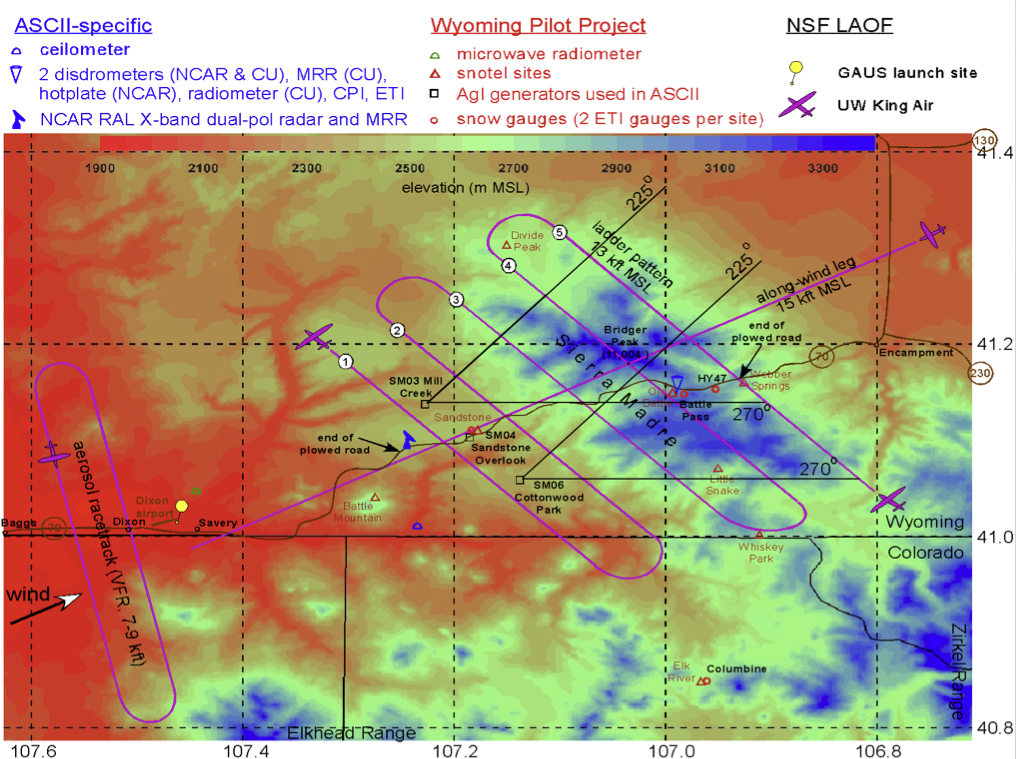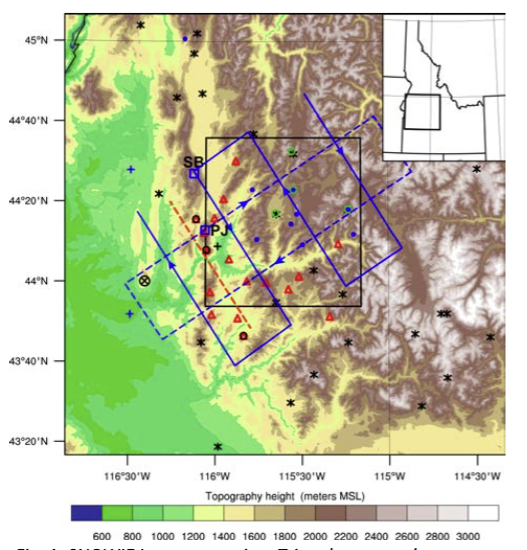SNOWIE experiment
SNOWIE experiment
 Seeded and Natural Orographic Wintertime clouds—the Idaho Experiment (SNOWIE) is a comprehensive observational and modeling research program to address longstanding uncertainties regarding the effectiveness of orographic winter precipitation enhancement through cloud seeding. The overarching goal is to understand the natural dynamical and microphysical processes by which precipitation forms and evolves within orographic winter storms and to determine the physical processes by which cloud seeding with silver iodide (AgI), either from ground generators or aircraft, impacts the amount and spatial distribution of snow falling across a river basin. A field campaign will be conducted in the Payette Mountain between January and March 2017 in coordination with Idaho Power Company (IPC) who maintains an operational seeding program in the region. The core scientific objectives are to: (1) Evaluate the role of mesoscale and microscale dynamics and of the underlying terrain in the formation, growth, and fallout of natural ice crystals in winter storms through observations; (2) Investigate how the natural snow growth process is altered as a result of airborne AgI seeding through both observations and model simulations, and (3) Evaluate the effects of ground seeding on snowfall amount and distribution. In addressing (2) and (3), we will evaluate and improve the newly-developed cloud seeding module used in the Weather Research and Forecasting (WRF) model. Select cases will also be simulated using a bin resolving microphysics scheme to further investigate the microphysical evolution of the natural and seeded clouds.
Seeded and Natural Orographic Wintertime clouds—the Idaho Experiment (SNOWIE) is a comprehensive observational and modeling research program to address longstanding uncertainties regarding the effectiveness of orographic winter precipitation enhancement through cloud seeding. The overarching goal is to understand the natural dynamical and microphysical processes by which precipitation forms and evolves within orographic winter storms and to determine the physical processes by which cloud seeding with silver iodide (AgI), either from ground generators or aircraft, impacts the amount and spatial distribution of snow falling across a river basin. A field campaign will be conducted in the Payette Mountain between January and March 2017 in coordination with Idaho Power Company (IPC) who maintains an operational seeding program in the region. The core scientific objectives are to: (1) Evaluate the role of mesoscale and microscale dynamics and of the underlying terrain in the formation, growth, and fallout of natural ice crystals in winter storms through observations; (2) Investigate how the natural snow growth process is altered as a result of airborne AgI seeding through both observations and model simulations, and (3) Evaluate the effects of ground seeding on snowfall amount and distribution. In addressing (2) and (3), we will evaluate and improve the newly-developed cloud seeding module used in the Weather Research and Forecasting (WRF) model. Select cases will also be simulated using a bin resolving microphysics scheme to further investigate the microphysical evolution of the natural and seeded clouds.
ASCII experiment
 The AgI Seeding Cloud Impact Investigation (ASCII) field campaign is designed within the context of the Wyoming Weather Modification Pilot Project (WWMPP). ASCII will target the Sierra Madre, a NW-SE oriented continental divide mountain range in southern Wyoming. ASCII focuses on studying the cloud microphysical effect of glaciogenic seeding using 3 generators in the Sierra Madre. ASCII will target the Sierra Madre under low-level flow from 225-270°, which provides a longer, rather unobstructed upwind fetch and a higher climatological probability of being able to sample enough “good” cases.
The AgI Seeding Cloud Impact Investigation (ASCII) field campaign is designed within the context of the Wyoming Weather Modification Pilot Project (WWMPP). ASCII will target the Sierra Madre, a NW-SE oriented continental divide mountain range in southern Wyoming. ASCII focuses on studying the cloud microphysical effect of glaciogenic seeding using 3 generators in the Sierra Madre. ASCII will target the Sierra Madre under low-level flow from 225-270°, which provides a longer, rather unobstructed upwind fetch and a higher climatological probability of being able to sample enough “good” cases.
ASCII will deploy a cloud radar and a cloud lidar aboard the University of Wyoming King Air (UWKA) aircraft, the Center for Severe Weather Research Doppler on Wheels radar, and several surface instruments (disdrometer, hotplate, microwave radiometer, microwave rain radar). The Wyoming Cloud Radar (WCR) is a 95 GHz (3 mm) Doppler radar with multiple fixed antennas. The Wyoming Cloud Lidar (WCL) is an incoherent backscatter polarization lidar operating at λ=0.355 um. In a mixed-phase cloud with ice crystals much larger but much fewer than cloud droplets, the WCR reflectivity is dominated by snow, whereas the WCL beam is attenuated mostly by liquid cloud edges.
ASCII is funded by the National Science Foundation (AGS-1058426) in cooperation with the Wyoming Weather Modification Pilot Project, which is funded by the State of Wyoming.
